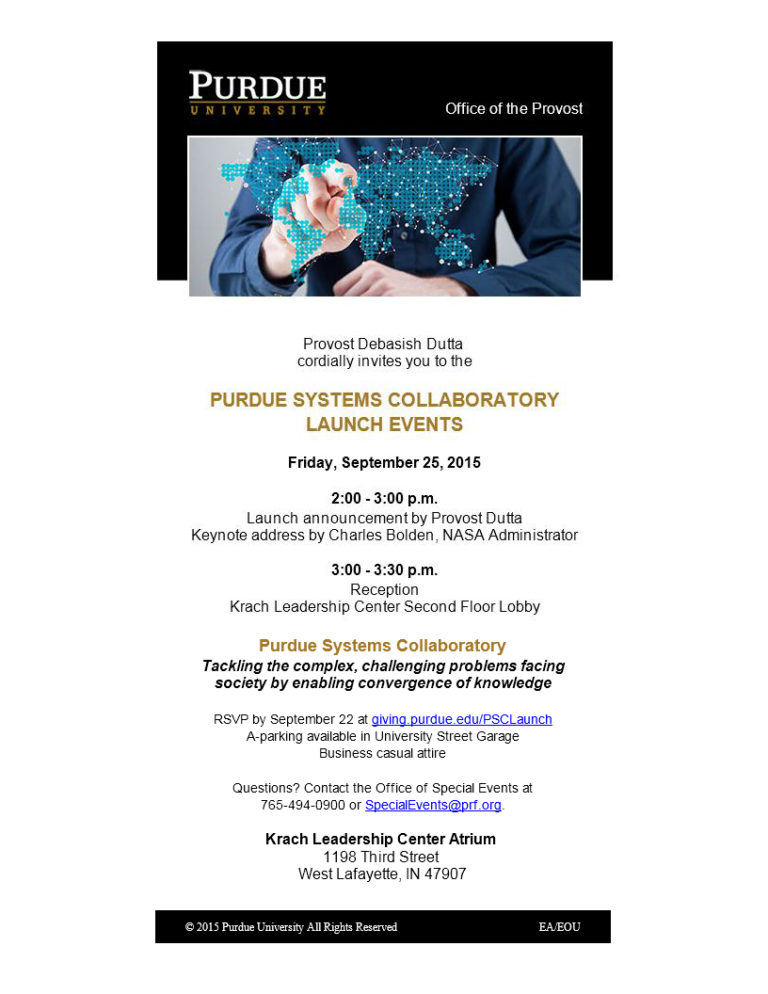Purdue Systems Collaboratory Launch Event
The Purdue Systems Collaboratory is a multi-disciplinary team of faculty interested in all things Systems – complexity, integration, systems tools, systems thinking, convergence, human systems, natural systems, human built systems, economic systems, political systems, and so on. To date, we have developed several prototype multi-college projects, facilitated conversations about systems-related activities and interests with faculty across the university, and elicited enthusiastic support from all of the deans.

Charlie Bolden, NASA Administrator
Maj. Gen. Charles Frank Bolden, Jr., (USMC-Ret.) was nominated by President Barack Obama and confirmed by the U.S. Senate as the 12th Administrator of the National Aeronautics and Space Administration. He began his duties as head of the agency on July 17, 2009. As Administrator, Bolden leads a nationwide NASA team to advance the missions and goals of the U.S. space program.
At NASA, Bolden has overseen the safe transition from 30 years of space shuttle missions to a new era of exploration focused on full utilization of the International Space Station and space and aeronautics technology development. He has led the agency in developing a Space Launch System rocket and Orion spacecraft that will carry astronauts to deep space destinations, such as an asteroid and Mars. He also established a new Space Technology Mission Directorate to develop cutting-edge technologies for the missions of tomorrow. During Bolden’s tenure, the agency’s support of commercial space transportation systems for reaching low-Earth orbit have enabled successful commercial cargo resupply of the space station and significant progress toward returning the capability for American companies to launch astronauts from American soil by 2017. Bolden has also supported NASA’s contributions toward development of developing cleaner, faster, and quieter airplanes. The agency’s dynamic science activities under Bolden include an unprecedented landing on Mars with the Curiosity rover, launch of a spacecraft to Jupiter, enhancing the nation’s fleet of Earth-observing satellites, and continued progress toward the 2018 launch of the James Webb Space Telescope, the successor to the Hubble Space Telescope.
Bolden’s 34-year career with the Marine Corps also included 14 years as a member of NASA’s Astronaut Office. After joining the office in 1980, he traveled to orbit four times aboard the space shuttle between 1986 and 1994, commanding two of the missions and piloting two others. His flights included deployment of the Hubble Space Telescope and the first joint U.S.-Russian shuttle mission, which featured a cosmonaut as a member of his crew.
Prior to his nomination as NASA administrator, Bolden was Chief Executive Officer of JACKandPANTHER LLC, a small business enterprise providing leadership, military, and aerospace consulting, as well as motivational speaking.
Born Aug. 19, 1946, in Columbia, S.C., Bolden graduated from C. A. Johnson High School in 1964 and received an appointment to the U.S. Naval Academy. He earned a Bachelor of Science degree in electrical science in 1968 and was commissioned as a second lieutenant in the Marine Corps. After completing flight training in 1970, he became a Naval Aviator. Bolden flew more than 100 combat missions in North and South Vietnam, Laos, and Cambodia, while stationed in Namphong, Thailand between 1972 – 1973.
Bolden earned a Master of Science degree in systems management from the University of Southern California in 1977. In 1978, he was assigned to the Naval Test Pilot School at Patuxent River, Md., and completed his training in 1979. While working at the Naval Air Test Center’s Systems Engineering and Strike Aircraft Test Directorates, he tested a variety of ground attack aircraft until his selection as an astronaut candidate in 1980.
Bolden’s NASA astronaut career included technical assignments as the Astronaut Office Safety Officer; Technical Assistant to the Director of Flight Crew Operations; Special Assistant to the Director of the Johnson Space Center in Houston; Chief of the Safety Division at Johnson (where he oversaw efforts to return the shuttle to flight safely after the 1986 Challenger accident); lead astronaut for vehicle test and checkout at the Kennedy Space Center in Florida; and Assistant Deputy Administrator at NASA Headquarters. After his final shuttle flight in 1994, he left NASA and returned to active duty with Marine Corps operating forces as the Deputy Commandant of Midshipmen at the U.S. Naval Academy.
Taken from NASA official website